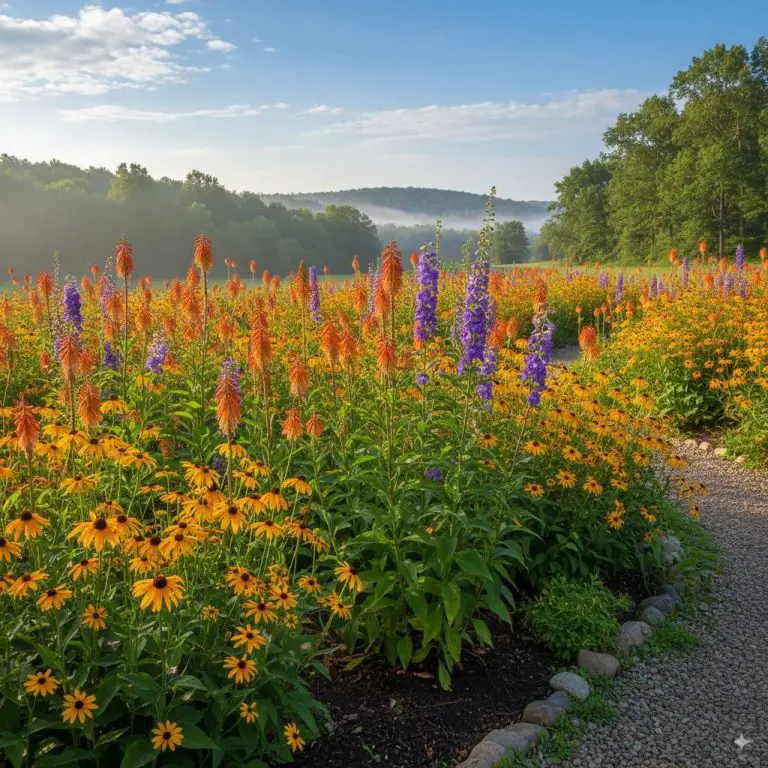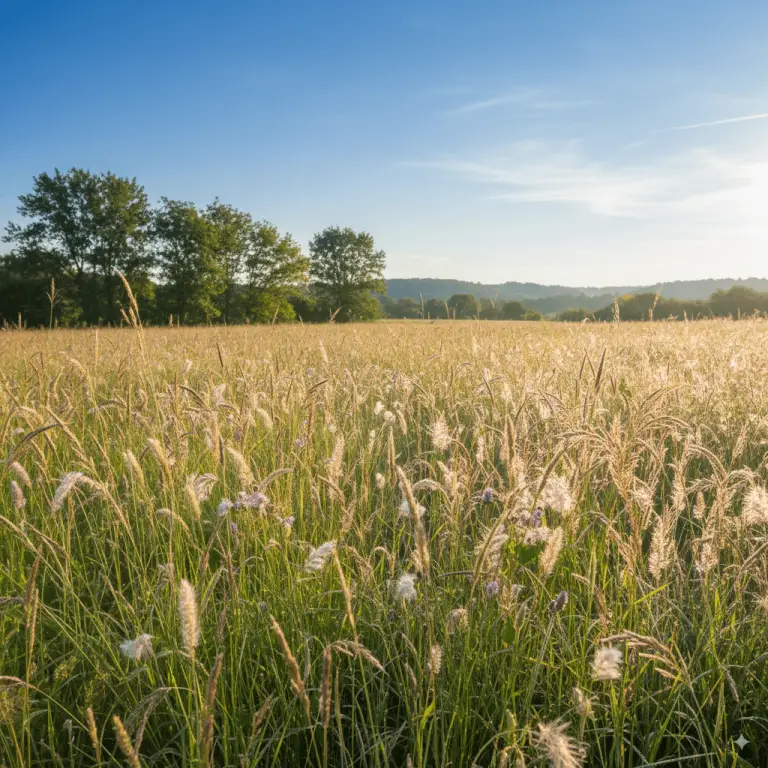Winter Flowering Heather Plants – The Complete Care Guide
Is your garden looking a bit drab and grey now that winter has settled in? It’s a common feeling among us gardeners. We spend all spring and summer cultivating vibrant color, only to watch it fade into a palette of browns and greys when the cold arrives.
I promise you, it doesn’t have to be this way. There’s a surprisingly tough, incredibly beautiful group of plants that not only survives the winter but positively thrives in it, bursting into a tapestry of pink, purple, and white blooms when you need them most.
Welcome to the wonderful world of winter flowering heather plants! They are the unsung heroes of the cold-season garden. In this complete guide, we’ll walk through everything you need to know—from choosing the perfect varieties and planting them for success to mastering their simple care and enjoying their year-round beauty. Let’s bring some color back to your winter landscape!
What's On the Page
- 1 Why Every Winter Garden Needs Heather
- 2 Choosing Your Perfect Winter Flowering Heather Plants
- 3 The Ultimate Winter Flowering Heather Plants Care Guide
- 4 How to Plant Heather for Season-Long Success
- 5 Solving Common Problems with Winter Flowering Heather Plants
- 6 Sustainable and Eco-Friendly Heather Gardening Practices
- 7 Frequently Asked Questions About Winter Flowering Heather Plants
- 8 Your Winter Garden Awaits!
Why Every Winter Garden Needs Heather
Before we dig into the “how-to,” let’s talk about the “why.” Adding these gems to your garden is one of the most rewarding decisions you can make. The benefits of winter flowering heather plants go far beyond just a pretty face.
A Splash of Defiant Color
Imagine looking out your window in the middle of January to see a carpet of vibrant pink flowers, completely unfazed by a light frost. This is the magic of winter heather. Their long-lasting blooms provide a crucial pop of color that lifts the spirits and transforms a dormant garden into a living landscape.

🌿 The Companion Planting & Gardening Book (eBook)
Bigger harvests, fewer pests — natural pairings & simple layouts. $6.99
Get – $6.99
🪴 The Pest-Free Indoor Garden (eBook)
DIY sprays & soil tips for bug-free houseplants. $4.89
Get – $4.99An Oasis for Early Pollinators
One of the most important aspects of eco-friendly winter flowering heather plants is their role in supporting wildlife. On milder winter days, brave bumblebees and other pollinators emerge in search of nectar. Winter heathers provide a vital, life-sustaining food source when little else is available, making your garden a crucial part of the local ecosystem.
Incredibly Low Maintenance
Don’t worry—these flowers are perfect for beginners! Once established, heathers are remarkably self-sufficient. They are drought-tolerant, resistant to most pests and diseases, and require very little fuss. This makes them a perfect “plant it and forget it” option for adding reliable structure and color.
Choosing Your Perfect Winter Flowering Heather Plants
Walking into a garden center, you might see a lot of plants labeled “heather.” But for that coveted winter color, you need to be specific. The true winter-blooming champions belong to the Erica genus, not their summer-blooming cousins, Calluna.
Here’s a simple breakdown to help you choose the right ones for your garden.
Erica carnea (Winter Heath or Alpine Heath)
This is the absolute superstar of the winter garden. Erica carnea is exceptionally hardy and, most importantly, is more tolerant of neutral to slightly alkaline soils than other heathers. This makes it the most versatile and forgiving choice for many gardeners.
- Blooms: December through April.
- Colors: Ranges from pure white and soft pink to deep magenta and ruby.
- Pro Tip: Varieties like ‘Myretoun Ruby’ (deep pink) and ‘Springwood White’ (bright white) are fantastic, reliable performers.
Erica x darleyensis (Darley Dale Heath)
A fantastic hybrid of Erica carnea and Erica erigena, this variety is known for its incredible vigor and extra-long blooming season. It forms lovely, dense mounds that are perfect for ground cover.
- Blooms: November through May.
- Colors: Predominantly shades of pink, lilac, and white.
- Pro Tip: ‘Kramer’s Rote’ is a famous variety with stunning magenta flowers, while ‘Ghost Hills’ offers a profusion of pink blooms.
What to Look For When Buying
When you’re at the nursery, choose a plant that looks healthy and vibrant. The foliage should be green or have its intended color (some varieties have beautiful golden or bronze foliage), not brown or grey. Look for a plant with plenty of buds, which promises a spectacular flower show to come.
The Ultimate Winter Flowering Heather Plants Care Guide
You’ve brought your beautiful new plants home. Now what? Following these winter flowering heather plants best practices will ensure they thrive for years to come. Their needs are simple, but specific.
The Golden Rule: Acidic, Well-Drained Soil
If you remember one thing from this guide, let it be this: heathers need acidic, well-drained soil to flourish. They hail from moorlands and hillsides where soil is naturally sandy, gritty, and low in nutrients.
If you have heavy clay or alkaline (chalky) soil, don’t despair! You can still grow them beautifully in containers or raised beds filled with an ericaceous (acidic) potting mix. For in-ground planting in less-than-ideal soil, amend the area generously with ericaceous compost and grit to improve drainage.
Sunlight: A Heather’s Best Friend
For the best flowering display and most vibrant foliage color, plant your heather in a spot that receives at least six hours of direct sunlight per day. While they can tolerate a little partial shade, a sunny location is truly where they perform their best.
Watering Wisely: The First Year is Crucial
During their first year, water your heather plants regularly to help them establish a strong root system, especially during dry spells. Once established, they are wonderfully drought-tolerant. A deep watering every couple of weeks during a prolonged drought is usually sufficient.
The key is to never let them sit in waterlogged soil, as this is the fastest way to cause root rot.
Pruning: The Secret to Bushy, Beautiful Plants
This is one of the most important winter flowering heather plants tips for long-term success. Pruning prevents your plants from becoming woody and “leggy.”
The rule is simple: trim them back once a year, right after they finish flowering in late spring. Use shears to trim off the old flower spikes, cutting back to just below the spent blooms. Be careful not to cut back into the old, brown wood, as it may not regrow from there.
How to Plant Heather for Season-Long Success
Ready to get your hands dirty? This simple, step-by-step process shows you exactly how to winter flowering heather plants for a thriving display. The best time to plant is in the autumn or spring.
- Step 1: Choose the Right Spot. Find a sunny location with good drainage. Remember, heathers look fantastic planted in drifts or groups of three, five, or more for a naturalistic look.
- Step 2: Prepare the Soil. Dig a hole that is twice as wide as the plant’s root ball but just as deep. If your soil isn’t naturally acidic, mix a generous amount of ericaceous compost into the soil you removed.
- Step 3: Tease the Roots. Gently remove the heather from its pot. If the roots are tightly wound (pot-bound), gently tease them apart with your fingers. This encourages them to grow outwards into the new soil.
- Step 4: Plant at the Right Depth. Place the plant in the hole, ensuring the top of the root ball is level with the surrounding soil. Planting too deep can lead to stem rot.
- Step 5: Backfill and Firm. Fill the hole back in with your amended soil, gently firming it around the base of the plant to remove air pockets.
- Step 6: Water Thoroughly and Mulch. Give the plant a good, deep watering. Apply a 2-inch layer of acidic mulch, like pine bark chips or pine needles, around the base. This helps retain moisture, suppress weeds, and maintain soil acidity.
Solving Common Problems with Winter Flowering Heather Plants
Heathers are generally trouble-free, but occasionally you might run into an issue. Here’s a quick look at some common problems with winter flowering heather plants and how to fix them.
Why is My Heather Turning Brown?
A browning heather is usually a sign of one of two things: too much water or not enough. The most common culprit is root rot from waterlogged, poorly drained soil. Check the soil around the base; if it’s soggy, drainage is your issue.
In rare cases, severe winter winds can cause “winter burn,” browning the foliage. The plant will often recover in spring. Established plants turning brown in the center is a sign of old age and a signal that it’s time to prune or replace it.
My Heather Isn’t Flowering
The top reasons for a lack of flowers are:
- Not Enough Sun: Move the plant to a sunnier location.
- Improper Pruning: Pruning at the wrong time (e.g., in autumn) can remove the flower buds that have already formed for winter. Only prune right after flowering ends in spring.
- Wrong Soil pH: If your soil is too alkaline, the plant will struggle to absorb nutrients. Test your soil and consider moving the plant to a container with ericaceous compost.
Sustainable and Eco-Friendly Heather Gardening Practices
Embracing sustainable winter flowering heather plants is easy because they are naturally eco-friendly. By planting them, you are already making a positive impact.
You can enhance this by using natural, peat-free ericaceous composts. Mulch with fallen pine needles from your garden or locally sourced bark chips. Because they thrive in low-nutrient soil, you can completely avoid chemical fertilizers, creating a healthier environment for your garden and the wildlife that visits it.
Frequently Asked Questions About Winter Flowering Heather Plants
Do winter heathers come back every year?
Yes, absolutely! Winter heathers are hardy evergreen perennials. With proper care, they will return year after year, growing larger and more beautiful each season.
Can I grow winter heather in pots?
Definitely! Growing heather in pots is a perfect solution if you have alkaline soil or heavy clay. Choose a pot with plenty of drainage holes and use a high-quality ericaceous potting mix. Container-grown heathers may need more frequent watering than those in the ground.
How far apart should I plant winter heathers?
For a dense, ground-cover effect, space your plants about 18-24 inches apart. This will allow them to grow together into a seamless carpet of color within a few seasons.
Your Winter Garden Awaits!
There you have it—everything you need to succeed with these incredible winter warriors. From their soul-lifting color on a grey day to their critical role in supporting pollinators, winter flowering heather plants are a must-have for any garden.
They prove that a garden’s beauty doesn’t have to go dormant when the temperature drops. So go ahead, find a sunny spot, and plant a drift of these hardy gems. Your future self—and your local bees—will thank you for it!
Happy gardening!
- How To Care For A Wilting African Violet: Your Complete Revival Guide - October 16, 2025
- African Violet Reblooming – 6 Simple Secrets For Constant Color - October 16, 2025
- Should You Mist African Violet Leaves – The Expert’S Guide To Avoiding - October 16, 2025


